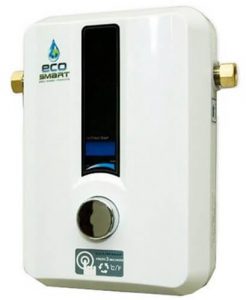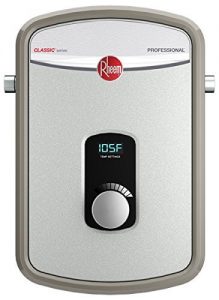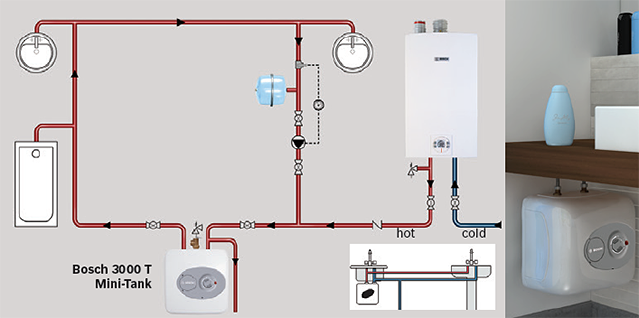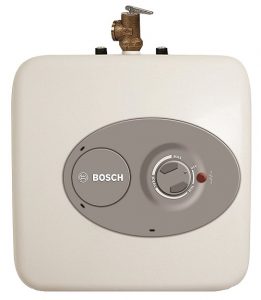Waiting for hot can be frustrating. Let’s face it; cold water just isn’t useful. Running a hot water line to every sink, shower, tub, and appliances can cost money and time and might not be practical. To get hot water quickly where its need a better solution is to use a point of use water heater.
What is a Point of Use Water Heater?
The point of use water heaters is, in essence, a mini water heater. They can either have a storage tank or be tankless. These heaters are designed to service one to two water outlets i.e. shower, garage or powder room. Due to their smaller size, they are ideal for residential applications and commercial applications where space is a premium.
These units should not be confused with an instant hot water dispenser. While conceptually they are the same, instant hot water dispensers have a limited storage capacity (under 0.75 gallons), and the water temperature can burn skin.
Kinds of Water Heaters
There are two kinds of point of use water heaters: tank and tankless. They both have pros and cons to each, but we will cover that in a few moments.
Water heaters with a Tank
A point of use tanked water heater is very similar to a traditional water heater but in a smaller size. These units have a small storage tank which is kept at a consistent temperature. The tank sizes vary from 2.5 gallons up to 20 gallons. Depending on what kind of fixture and the number fixtures the unit will determine the tank size you will need.
Benefits
- Almost instant hot water delivery
- Minimum waste of water waiting for lines to clear or water to heat up
- Large variety of units to select from
- Normally easy to install.
Tankless Water Heaters
A tankless point of demand water heater does not have the storage tank and functions in the same fashion as a whole house tankless water heater. The heater does not store any water but heats the water when there is a call for water, this saves energy buy heating water when it’s needed, instead of keeping the water in a tank hot. However, there is a trade-off, there is a slight delay between when there is a call for water and when hot water arrives at the point of delivery. Most of these units available to consumers are rated 2.0 to 2.5 gallons per minute. The nice feature about a tankless heater is you will never run out of hot water.
Benefits
- Endless supply of hot water
- Saves energy by only heating water when it’s needed
- Typically, smaller than a tanked water heater
When Should I Use a Point of Use Water Heater and what are their advantages?
You are in a hurry: A point of use water heater is going to deliver hot water much faster than a traditional whole house water heater. Since the unit is located close to the destination, you will not need to wait for the to clear the lines.
You Want to conserve water and/or energy: As mentioned above, the heater is located close to the point of use, you will not be wasting water waiting for hot water to arrive at the destination. This can save hundreds of gallons of water per month. If that water is left in the pipe, it’s a waste of energy. The diagram below displays this.
Here is a typical example: The distance from your whole house water heater is 40 linear feet of ½ copper pipe. From the water heater to your kitchen sink might not be 40 feet, but the distance water has to travel in the copper piping might be 40 linear feet.
40 feet of ½ pipe holds 0.45 gallons (source) So everytime you turn on the hot water you have to clear 40 feet (0.45 gallons of water) before you receive hot water at your kitchen sink. Clearing the line just wasted 0.45 gallons of water and the energy to heat that water.
Using a point of use water heater the same scenario looks like this. You install a unit under the kitchen sink. The total distance is two linear feet of ½ copper piping, which holds 0.02 gallons of water. Now you are only clearing a tiny amount of water before getting hot water at your kitchen sink.
I agree 0.45 gallons of water might seem to look like an insignificant amount, but let look at this over the course of a year. Let’s say you have to clear the water three times during a day, once for when you wake up, once for when you once come home and cook dinner and finally right before bed. During 1 day, you are wasting 1.35 gallons of water and the corresponding energy to heat that water. Now, let’s look at that over one year; you are losing almost 530 gallons of water. To give you an idea of how much 530 gallons of water is, fill up your bathtub full of hot water and let it drain. Now do this 13 times, and that is how much water you are wasting per year.
Remodeling and/or Additions: If you are undertaking an extensive remodeling project where you are moving rooms around, it might make more sense to install a point of use heater instead of reconfiguring all the piping. When adding additions to a house, this is a very good time to consider one of these units for a couple of reasons. First, your current water heater might not be sufficient to support the additional demand. Also, when your home was originally built the architect/engineer most likely placed your HVAC and water heater in the same location to most efficiently deliver hot water and climate control air. Since you are adding more space, your water heater is most likely located too far away to effectively provide hot water. Finally, is the cost. In some instances it might be cheaper to install a point of use water heater, then to pay a plumber to run two lines (hot and cold) to the new outlet.
Remote Location: A point of use heater is a great addition to a garage or outdoor living space. They added convenience is one of the life’s simpler things. The one important thing is if you live in a cold climate make sure to follow the manufacturer’s directions on how to winterize the unit. If you don’t winterize it, you could be dealing with a costly mess come to the spring thaw.
Understanding Flow Rate
We mention Flow Rate several times in this article and wanted to make sure you understand what it is and why it is important when picking out a water heater. The flow rate is the amount of water a fixture uses in a given time. The common measurement is Gallons Per Minute (GPM). Appliances and fixtures vary by the manufacture and their age. Older fixtures typically have a higher GPM than modern ones. Below is a chart which provides the average GPM for fixtures and appliances which need hot water.
Flow Rate Chart
These are the average flow rate for appliances and fixtures in a house. Flow rate is measured in Gallons Per Minute (GPM)| Fixture | GPM Range | Average GPM |
|---|---|---|
| Bathtub | 2.0 - 4.0 | 3.0 |
| Bathroom Sink | 0.5 - 1.5 | 0.75 |
| Shower | 1.5 - 5 | 3.25 |
| Kitchen Sink | 1.0 - 3.0 | 1.5 |
| Dishwasher | 2.0 - 3.0 | 2.5 |
| Clothes Washer | 1.5 - 3.0 | 2.25 |
Installing a POU Water Heater
Installing an electric point of use water heater is very straight forward. If you already have an outlet, it’s a matter of plugin in the unit and connecting the supply lines. This can easily be done in under an hour. However, if you don’t have the right electrical requirements things can become challenging. The smaller units run on 120v (typical house outlet), The larger units 5 gallons and more normally run on 240V, this is what your oven and dryer use, assuming they are electric.
If you choose a gas tankless version, then there will be some additional cost. The unit will need to be vented to the outside of your house, so not to release CO2 into the home. Also, a gas line will need to be run to the unit.
Best Point of Use Water Heater for a Shower
When picking a water heater for a shower, you need to consider a few things. First, consider the number of people who are going to be taking a shower in during a given time span. The average American shower consumes 14.8 gallons of water. From our research, the average storage tank size for a point of use is 2.5 gallons. We could not find any point of use tanks larger than 7 gallons. A typical shower has a flow rate of 1.5 gallons per minute. This means for every minute you have the shower on you are using 1.5 gallons. With such a high flow rate even a 7-gallon tank would only be able to produce enough hot water for a 4-minute shower. Four minutes is half the national average for shower times according to the EPA.
The best option would be to use a tankless point of use water heater. A tankless water heater is going to give you an endless supply of hot water. The initial installation will typically cost more, but we believe is the best option for showers. Below are the top 2 point of use water heaters for a shower.
EcoSmart ECO11 Electric Tankless Water Heater Review
EcoSmart’s line of electric tankless water heaters has revolutionized the water heater industry. Their products help you save money, save space and conserve energy. They developed and patented a self-modulating technology which makes their units one of the most energy efficient units on the market. Self-modulating means the water heater adjusts the amount of energy used based on the flow of water. So if you are running a sink (0.5 GPM), it will only use enough energy to heat 0.5 GPM, but if you are running a shower (1.5 GPM) it will increase the energy used to meet the higher demand.
The ECO 11 is one of the best points of use water heaters on the market. With the stylish design, you almost don’t need to hide it away in a closet. The digital temperature control in 1-degree increments allows for pinpoint control to dial in your perfect shower temperature. One of the best features of this unit is it has 0.25 GPM activation flow. Activation flow is the rate at which the water needs to flowing before the unit will turn on.
The ECO 11 requires a 240 single phase electrical connection. It also draws 57 amps at peak use, so you will need a 60 amp circuit breaker. The only downfall to this unit is the may not perform well in the extreme northern United States, such as Montana, Idaho, North Dakota and parts of South Dakota. If you live in any of those locations, you will need to purchase their next level up the ECO 18 or the ECO 27.
Rheem RTEX 13 Tankless Water Heater Review
 Like EcoSmart, Rheem has been an innovator in the water heater space. This a great unit for anyone who is looking a to buy from a very reputable brand. Rheem has been making tankless water heaters for a very long time and has received high reviews from other 3rd party sources.
Like EcoSmart, Rheem has been an innovator in the water heater space. This a great unit for anyone who is looking a to buy from a very reputable brand. Rheem has been making tankless water heaters for a very long time and has received high reviews from other 3rd party sources.
While the price point of the RTE 13 is slightly higher, it does provide high gallons per minute temperature rise. This is a well-built unit which uses a rugged brass and copper heat exchanger. This unit also has to modulate heat exchanger. Finally, the RTEX 13 is one of the smaller units we looked at, so if space savings high on your priority list, you will want to consider this unit.
The Rhem RTEX 13 requires a dedicated 60 AMP breaker.
Shower Water Heater Comparison Table
| Specifications | ECOSmart ECO 8 | ECOSMart ECO 11 | Rheem RTEX-11 | Rheem RTEX-13 |
|---|---|---|---|---|
 |  |  |  |
|
| KW | 8 | 13 | 11 | 13 |
| Voltage | 240 | 240 | 240 | 240 |
| Max Amp | 33 | 57 | 46 | 54 |
| Required Breaker | 1 x 40 AMP | 1 x 60 AMP | 1 x 40 AMP | 1 x 60 AMP |
| Required Wire** | 8 AWG | 6 AWG | 6 AWG | 6 AWG |
| Exchanger | Stainless Steel | Stainless Steel | Cooper | Cooper |
| Temp Control | Digital | Digital | Digital | Digital |
| Activation Flow | 0.25 GPM | 0.25 GPM | 0.30 GPM | 0.30 GPM |
| Warranty | Lifetime* | Lifetime* | 5 Year | 5 Year |
| Size | 11.5" x 8" x 3.75" | 11.5" x 8" x 3.75" | 12.625" x 8.25" x 3.625" | 12.625" x 8.25" x 3.625" |
| Weight | 4.75 lbs | 6.5 lbs | 8.5 lbs | 8.5 lbs |
| Water Connections | 1/2" CF | 1/2" CF | 1/2" CF | 1/2" CF |
| 1 GPM Temp. Rise | 53 | 79 | 75 | 89 |
| 1.5 GMP Temp. Rise | 36 | 58 | 50 | 59 |
| 2 GPM Temp. Rise | 28 | 45 | 38 | 44 |
| 2.5 GPM Temp. Rise | N/A | 36 | 30 | 36 |
| 3 GPM Temp Rise | N/A | 30 | 25 | 30 |
| Check Price | Check Price | Check Price | Check Price |
** Longer Wiring lengths may increase the need for a larger wiring. Check the manufactures installation manual
Best Point of Use Water Heater for a Kitchen
The kitchen hot water needs are very similar to a bathroom but on a larger scale. Except turning on the water to clean your hands, most of the time your kitchen sink will be on for a few minutes, to rinse the dinner dishes, fill up pots full of water or to fill the coffee maker. The point is your kitchen sink is not like a bathroom sink where its on for a few moments then off for hours at a time. Let’s take a closer look at water usage in a kitchen. The kitchen faucet has a flow rate of 1 GPM to 2.5 GPM. The average kitchen sink holds 2.5 – 4 gallons of water. A dishwasher has a flow rate 1.5 GPM and uses about 6 gallons of water. During one meal, you could easily use 15 gallons of hot water.
The problem with the kitchen is the most of the uses are a short burst. For example, you need to rinse a cutting board quickly or wash your hand because you just touched raw chicken. All of these short burst add up quickly. Then after dinner, the demand increases for rinsing plates, cleaning pots and pans and then running the dishwasher. While a point of use tankless water heater sounds good, there is still a delay from the time you turn on the faucet to the time the tankless heater can supply hot water.
The ideal solution is to install a higher capacity point of use water heater with a storage tank and provide this heater with hot water from the house’s central water heater. (see diagram below) The point of use water heater acts as a supplement for the main water heater.

BOSCH T 7-Gallon Electric Mini-Tank Under Sink Water Heater Review
 Bosch is one of the strongest brands when it comes to water heaters. With their length history of building some of the finest water heaters, you can’t go wrong with this unit.
Bosch is one of the strongest brands when it comes to water heaters. With their length history of building some of the finest water heaters, you can’t go wrong with this unit.
The Bosch T is designed to fit easily under your sink. It can be mounted to the wall or secured to the floor, with the supplied bracket. The engineers at Bosch created stylish exterior to blend seems into almost any décor. The high energy efficiency of this unit means there is limited standby loss, which means energy savings for you. The glass lined tank gives the heater a longer lifespan, especially if you higher chlorinated water.
The 7-gallon capacity makes it ideal for a supplement to your house’s main water heater. If the 7-gallon capacity is too large, they do make a smaller 4-gallon capacity too.
Ecosmart ECO MINI 6 Electric Point of Use Water Heater Review
 While Ecosmart is not the first company to make water heaters, they focus strictly on electric water heaters. They make some of the finest electric water heaters on the market. The Mini 6 was designed to fit nicely under a kitchen sink. The great thing about this unit is it runs on 120 and only draws 12 amps, so in most cases, you will not need run any additional electric lines. The installation is relatively straightforward, and most Diy’ers can install this in an afternoon.
While Ecosmart is not the first company to make water heaters, they focus strictly on electric water heaters. They make some of the finest electric water heaters on the market. The Mini 6 was designed to fit nicely under a kitchen sink. The great thing about this unit is it runs on 120 and only draws 12 amps, so in most cases, you will not need run any additional electric lines. The installation is relatively straightforward, and most Diy’ers can install this in an afternoon.
Like the Bosch unit, this is rather large for a point of use water heater, so depending on your cabinet space you might have to opt for the ECO Mini 4. Also, while it does run on 120, it still needs to be hard wired. The unit comes with a 40” pigtail, so check to see if that will reach your current outlet.
Kitchen Sink Water Heater Comparison Table
| Specifications | BOSCH T 7-Gallon | ECOsmart 6 | Stiebel Eltron 6- SHC 6 | WaiWela WM-6.0 |
|---|---|---|---|---|
 |  |  |  |
|
| Storage Capacity | 7.0 Gallons | 6.0 Gallons | 6.0 Gallons | 6.0 Gallon |
| Voltage | 120 | 120 | 120 | 110 V |
| Max Amp | 12 | 12 | 11.3 | 12 |
| Temp Control | Dial | Dial | Dial | Dial |
| Warranty | 1 year | 5 years leaks/ 1 year parts | 6 Years leaks / 2 parts | 6 year tank / 2 year parts |
| Size | 17.5" x 14.5" x 17.5" | 20" x 13.8" x 14.5" | 15" x 15.1" x 20.5" | 15.5" x 15.8" x 18" |
| Max Temperature | 145°F | N/A | 140°F | 140°F |
| Made In | N/A | China | Germany | N/A |
| Weight | 29.5 lbs | 25 lbs | 26.5 lbs | 26 lbs |
| Check Price | Check Price | Check Price | Check Price |
The best point of use water heater for sinks
The bathroom sink is where the point of use water heaters really excels. A bathroom sink has an average flow rate of .75 gallons per minute. Experts suggest to wash your hands for at least 20 seconds, and most people don’t. A 1 to 2-gallon water heater will supply enough hot water for most ½ baths.
The great thing about these smaller units is they only need 120V 15 amp circuit to run correctly. This is a common outlet, which means you will most likely not need to run any additional electricity. Small in size, these units fit nicely under most bathroom sinks. Finally, they are a low-cost solution for a very common problem.
Bosch T 2.5 Gallon Electric Point of Use Water Heater Review
As stated before, Bosch is an industry leading in water heating appliances. This model is ideal for bathroom sinks because of its larger capacity of 2.5 gallons. Also, it runs off a standard 120-volt outlet. The unit can be wall mounted our mounted to the floor with a supplied bracket. If you install this directly under your sink, you can expect hot water to the sink in less than 2 seconds. With the large 2.5 gallon capacity, you can have a supply of hot water for a little over 3 minutes.
The unit is very easy to install. A plumber can have it up and running in 30 minutes. A DIY’er will take around an hour to install correctly. The 3’ cord makes it easy to reach most outlets. The Bosch T 2.5 is by far the best bang for the buck.
WaiWela WM-1.0 Mini Tank Water Heater Review
While WaiWela might not be a big brand like Bosch, they have been making water heaters since 1977. The WM-1.0 will supply about 60 to 90 seconds of heated water, which is more than enough for a seldom used powder room. If you need more storage volume, they do have a 2.5 gallon, 4 gallons, and 6-gallon units. All of the units run off 120 volts and be a 15 amp circuit breaker.
The WM-1.0 was the smallest tanked water heater we could find, so this will fit nicely in those hard to reach areas. Also, you can use this inline to supplement your whole house system if needed. As with most units like this installation should take you about an hour to get it up and to run.
The point of use water heater is a great way to solve and age old problem of getting hot water to the destination in an expedient manner. This unit uses very little energy, help save on water waste and are typically easy to install. Most heaters can be installed by a plumber in under an hour. The average DIY’er can install a water heater in an afternoon. Stop waiting for hot water, pick one of these great heaters up today.
Bathroom Sink Water Heater Comparison Table
| Specifications | BOSCH T 2.5-Gallon | WaiWela WM- 1.0 | Ecosmart ECO MINI 1 | Eccotemp EM-2.5 |
|---|---|---|---|---|
 |  |  |  |
|
| Storage Capacity | 2.5 Gallons | 1.3 Gallons | 1.5 Gallons | 2.5 Gallon |
| Voltage | 120 | 120 | 120 | 120 |
| Max Amp | 12 | 12 | 12 | 15 |
| Temp Control | Dial | Dial | Dial | Dial |
| Warranty | 1 year | 6 year tank / 2 year parts | 5 Years leaks / 1 parts | 5 year tank / 2 year parts |
| Size | 13.75" x 13.75" x 10.75" | 10" x 11" x 12.5" | 14.5" x 10" x 10" | 12" x 12" x 20" |
| Max Temperature | 145°F | 140°F | 140°F | 140°F |
| Weight | 15.5 lbs | 12.5 lbs | 15 lbs | 17.9 lbs |
| Check Price | Check Price | Check Price | Check Price |